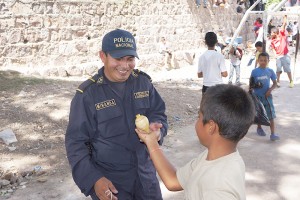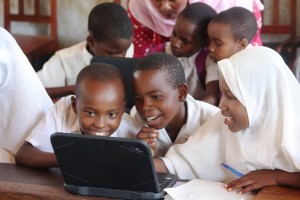15 development trends to watch for in 2015
January 14, 2015
2015 is expected to be a big year in global development, and Creative experts weighed in on the trends and changes they anticipate. From social investing to yoga, here are 15 things to watch in 2015.
1. Real-time and open data
Funders and NGOs will continue to improve data collection and management so project information is increasingly available for real-time analysis and decision-making.
A continued push for information transparency will lead more governments, funding agencies and implementers to make their data openly available. USAID helped put this on the agenda for 2015 by releasing these Development Data guidelines in fall 2014.
From Jacqui Deelstra, Associate, Technology for Development and Ayan Kishore, Senior Associate, Technology for Development
2. Answers on the poverty-growth relationship
Does macroeconomic growth for countries mean better lives and incomes for its citizens?
In 2015, we might learn the answer and just how these correlates between growth and poverty reduction work, if they exist. USAID is currently conducting a multi-country study using the Inclusive Growth Index (IGI) —a methodology to assess countries’ economic condition and the role increased trade and investment have had on the lives of individuals and households in developing countries.
Expect more research on the poverty-growth relationship from donors and development experts this year.
From Jerry Wright, Senior Director, Economic Growth Division
3. Focus on urbanization and youth migration
Cities are the next frontier for economic, technological and social development, according to the private sector. Meanwhile, youth migration patterns will affect urban development programs. Empowering and providing opportunities to young people in cities and will be a development priority in 2015.
From Bonnie Politz, Senior Advisor for Youth, and Magdalena Fulton, Senior Associate for Youth and Elizabeth Mullen, Program Associate for Youth
4. A neighborhood-based approach to crime and violence prevention
 In fall 2014, Vanderbilt University released the results of a three-year study showing that community-based violence prevention programs in at-risk neighborhoods across Central America have improved residents’ perceptions of security—51% fewer residents reported being aware of murders, extortion or blackmail and 35% fewer residents reported avoiding dangerous areas out of fear of crime.
In fall 2014, Vanderbilt University released the results of a three-year study showing that community-based violence prevention programs in at-risk neighborhoods across Central America have improved residents’ perceptions of security—51% fewer residents reported being aware of murders, extortion or blackmail and 35% fewer residents reported avoiding dangerous areas out of fear of crime.
In 2015, expect implementers to focus on the neighborhood level where crime and violence prevention can generate significant results.
From Guillermo Cespedes, Director, Crime and Violence Prevention
5. More “Om”
For children and youth—particularly those at risk—mindfulness, meditation and yoga practices bring about calmer focus and inner balance, resulting in reduced anxiety and stress and greater self-control and self-awareness.
Expect to see a growing awareness of the power of these methods and an increased willingness to use them in programming.
From Eileen St. George, Director, Education in Conflict
6. Cutting-edge university innovations on electoral integrity
 In 2015, nine innovative partnerships between USAID and U.S. universities will conclude, producing cutting-edge research we can expect to influence recommendations to USAID’s Center of Excellence on Democracy, Human Rights and Governance.
In 2015, nine innovative partnerships between USAID and U.S. universities will conclude, producing cutting-edge research we can expect to influence recommendations to USAID’s Center of Excellence on Democracy, Human Rights and Governance.
Out of the research, we will see innovations that strengthen programs and field missions including an Election Results Evaluation Tool; a sophisticated forensic instrument to assess whether elections are free and fair; findings on whether vote-buying efforts truly affect how citizens vote; and research on the impact of election observers on fraud, political representation and accountability.
From Tihana Bartulac Blanc, Senior Associate, Electoral Education and Integrity
7. Mainstreaming technology for development & peacebuilding
 Development professionals in 2014 increasingly discussed lessons learned and best practices for the use of technology for development, including the Principles for Digital Development, an initiative supported by a large coalition of funding agencies and international organizations.
Development professionals in 2014 increasingly discussed lessons learned and best practices for the use of technology for development, including the Principles for Digital Development, an initiative supported by a large coalition of funding agencies and international organizations.
Peacebuilding actors also generated new technologies and initiatives to stem conflict and address humanitarian crises. In 2014, USIP launched the USIP PeaceTech lab. These tools can be used to combat gangs and terrorists who use technology as a means for recruitment and intimidation
In 2015, using this knowledge, technology interventions will become even more integral to development work in all sectors, including peacebuilding and conflict resolution, and will be better designed and implemented.
From Jacqui Deelstra, Associate, Technology for Development and Ayan Kishore, Senior Associate, Technology for Development
8. More social investing
While social investing became trendy in the United States in the 1980s, it did not come into vogue in development assistance until much later, when movements such as the Calvert Social Fund, the Clinton Foundation and the Business Call to Action emerged.
Uptake on social investing by corporations and donors may have been slow, but the impacts of social investing have been impressive. Now, it’s a key feature on the post-2015 development agenda.
From Jerry Wright, Senior Director, Economic Growth Division
9. A move beyond “training” to human and institutional capacity development
With USAID focusing more on human and institutional capacity development, implementers are following suit and reshaping their approaches.
Consistent with this trend, Creative is moving beyond just training to implementing its Collaborative Approach to Performance Support that builds individual, organizational and systemic capacity with diverse results-based tools.
From Michael McCabe, Senior Associate, Training and Capacity Development
10. Youth voice and authentic engagement
In the past year, we saw young people shape discussions on the UN’s post 2015 development goals; Malala Yousafzai receive the Nobel Prize for her courageous work to promote girls’ education; and closer to home, organizations like the Alliance for International Youth Development amplify youth voice at the Interaction Forum 2014. Programs designed with and by youth are more targeted, effective, and sustainable according to global research and evidence generated by Creative’s youth-led programs in Morocco and Central America.
Embedding youth voice and authentic youth engagement will be critical to all aspects of programs in 2015.
From Bonnie Politz, Senior Advisor for Youth, Magdalena Fulton, Senior Associate for Youth and Elizabeth Mullen, Program Associate for Youth
11. Blended learning and leveraging mobiles
By the end of 2015, the global e-learning market is expected to double from its 2011 worth of $35 billion to almost $70 billion. The development field is embracing the e-learning revolution that allows staff, partners and beneficiaries to learn “soft” and “hard” skills anytime, anywhere.
CreativeU.com and other platforms are aggregating quality, mobile-friendly courses and converting formerly instructor-led trainings into dynamic models that blend in-person with mobile learning, which have demonstrated better long term retention.
This year, mobile apps and educational games will continue to advance, giving youth engaging tools to interact with curriculum and create and share their stories, real or fiction, in ways that stimulate their minds creatively, emotionally, intellectually and with purpose.
From Michael McCabe, Senior Associate, Training and Capacity Development, and Eileen St. George, Director, Education in Conflict
From Eileen St. George, Director, Education in Conflict
12. A “gender data revolution”
 In December 2014, Hilary Clinton announced six new partnerships to extend Data2X, an initiative launched in 2012 to spur a “gender data revolution” and advance gender equality and women’s empowerment globally through evidence-based policy and programs. Expect an even stronger push for gender-relevant data this year along with more demand for lessons learned in gender and development.
In December 2014, Hilary Clinton announced six new partnerships to extend Data2X, an initiative launched in 2012 to spur a “gender data revolution” and advance gender equality and women’s empowerment globally through evidence-based policy and programs. Expect an even stronger push for gender-relevant data this year along with more demand for lessons learned in gender and development.
Donors, including USAID, will continue to emphasize gender integration in projects and require more systematic approaches that involve gender analysis and strategies, draw on data and evidence and demonstrate results.
From Rekha Martin, Senior Associate, Gender
13. Using effective local governance to build state efficacy
Strengthening effective local governance will be a priority in 2015. The Busan New Deal and USAID Local Systems’ Framework present a platform that calls for better understanding of the political economies of countries and communities to meet this challenge.
State-society relations will be a key focus area this year—and in the post-2015 development agenda—in achieving peacebuilding and state-building.
From Deborah Kimble, Director, Governance and Civil Society
14. Enhanced career preparation and job entry programs
Today, the fastest growing jobs throughout the world are “digital” and technology-based. Youth will seek out training this year in computer and technology skills in order to take advantage of the economic opportunities in today’s economy. Green jobs and investments in agriculture will also create employment opportunities for youth.
From Bonnie Politz, Senior Advisor for Youth, Magdalena Fulton, Senior Associate for Youth and Elizabeth Mullen, Program Associate for Youth
15. Measuring human capital development
There are three strands of measurement for evaluating success and returns on investments in human capital: education, health and economic returns to individuals and households. It took a lot of work and debate for the development community to come to this consensus.
Now in 2015, Creative’s experts will work with and alongside both USAID and the Millennium Challenge Corporation to define how best to design projects that improve human capital development, and also measure their impact on markets, economies and—in the end—standards of living for people in developing countries.
From Jerry Wright, Senior Director, Economic Growth Division

